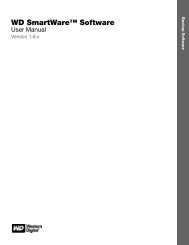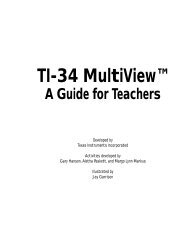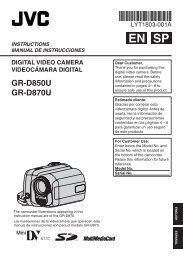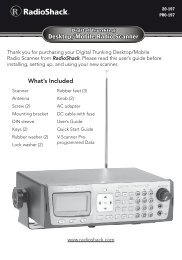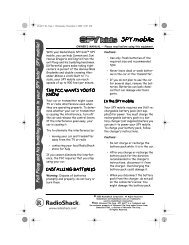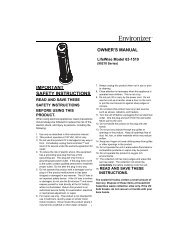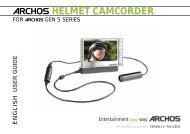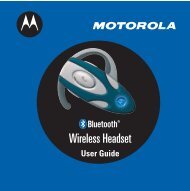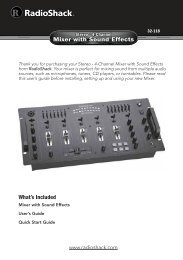Digital Trunking â Desktop/Mobile Radio Scanner - Radio Shack
Digital Trunking â Desktop/Mobile Radio Scanner - Radio Shack
Digital Trunking â Desktop/Mobile Radio Scanner - Radio Shack
You also want an ePaper? Increase the reach of your titles
YUMPU automatically turns print PDFs into web optimized ePapers that Google loves.
Creating Scannable Objects<br />
Creating Scannable Objects<br />
• When you press a key, the associated letters appear on the<br />
screen. Press the corresponding number. For example, when you<br />
press ABC, A, B, and C appear on the display. To select A, press<br />
1. To select B, press 2. To select C, press 3.<br />
• For example, to enter the tag “FIRE”:<br />
Press 3 (DEF), then 3 to choose F<br />
Press 4 (GHI), then 3 to choose I<br />
Press 7 (PQRS), then 3 to choose R<br />
Press 3 (DEF), then 2 to choose E<br />
• To enter a number, press 1, then press the number key.<br />
• To enter lowercase character or second-set character for the 0<br />
key, press the text key and then press FUNC.<br />
• Press or to move the cursor to another digit to make<br />
adjustments.<br />
• Press CLR to clear text. Press FUNC CLR to clear the entire field.<br />
4. Press ENT or the DONE softkey to store new tag information.<br />
See “Appendix C: Text Entry and QuickText” on page 115 for more<br />
information on entering text.<br />
<strong>Trunking</strong> Talkgroup Objects (TGRP)<br />
A <strong>Trunking</strong> Talkgroup Object (TGRP) is a record that stores the<br />
parameters for a trunked talkgroup on a trunked radio system.<br />
A TGRP object allows you to scan and monitor a talkgroup on a<br />
particular trunked radio system.<br />
Essential Parameters<br />
As a standalone object, a TGRP object is similar to a CONV object.<br />
However, for trunking to work, the trunking system (TSYS) and the<br />
talkgroup ID must be specified. We also recommend that you label<br />
your TGRP object by giving it a name in the TAG field, making it<br />
easier to find the TGRP object later, and identifying it when the<br />
scanner stops to monitor activity.<br />
<strong>Trunking</strong> System (TSYS) Objects<br />
The first time you make a TGRP for a particular trunked radio<br />
system, you must also create a TSYS object that contains the system<br />
parameters associated with that trunked radio system. Once you<br />
create a TSYS, you can use it over and over again without having to<br />
re-enter all of the system data.<br />
A TSYS object has its own set of essential parameters, and these<br />
parameters vary depending on the type of trunked radio system<br />
you plan to monitor. If you are a reasonably experienced user, you<br />
probably already know what the essential parameters are for the<br />
system you wish to monitor. For example, each TSYS must correctly<br />
specify the type of system being monitored, the control channel<br />
or LCN frequencies used by the system, and so on. A detailed<br />
description of each type of system supported by this radio and<br />
the essential parameters required to make them work properly is<br />
provided in “Appendix B: Detailed Menu Reference: TSYS Menu” on page<br />
106.<br />
Note: By default all new objects are mapped to Scan List 01. Refer to<br />
“Grouping Objects with Scan Lists” on page 39 for more information on Scan<br />
Lists.<br />
To create a new TSYS object.<br />
1. Press PROG to put scanner in Program Mode.<br />
2. Press NEW softkey to create new object.<br />
3. Press TGRP softkey to create a trunking system object.<br />
<br />
> Talkgroup <<br />
Scan Lists: *01<br />
TSYS:<br />
NEW<br />
Save Exit Dflt<br />
30<br />
31



